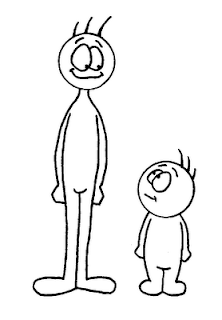 I usually have all fun stuff on my blogs, but it’s time to practice some grammar. There will be times when you need to compare one thing to another and here is how to make comparisons in a nut-shell. The rules sections are very detailed rules, it’s not important to memorize them, I just want to make sure you have all of the information.
I usually have all fun stuff on my blogs, but it’s time to practice some grammar. There will be times when you need to compare one thing to another and here is how to make comparisons in a nut-shell. The rules sections are very detailed rules, it’s not important to memorize them, I just want to make sure you have all of the information.
There are three types of comparatives: superiority, inferiority and equality. They are formed with adjectives or adverbs.
Examples:
I have a spicier pizza than you do – superiority
You have fewer shoes than I do – inferiority
He is as bald as that man over there. – equality
Superiority shows something it better than something else. The inferiority shows that something is worse than something else and equality shows that something is equal to something else.
Rules:
The rules for forming comparatives are: if there is only one syllable which ends in ‘e’, you add an ‘r’ to the end. If there is a word with only one syllable with one vowel and one consonant at the end of the word, an ‘er’ is added to the end, after doubling the last consonant. Other instances of 1 syllable words, add an ‘er’ to the end of the word. If there is a two syllable word ending in ‘y’, then change the ‘y’ to an ‘i’ and add ‘er’. If the word has two or more syllables and does not end in ‘y’, then use the word ‘more’ before the adverb or adjective.
Superlatives work similar to comparatives. There are superiority and inferiority forms of superlatives.
Examples:
That is the prettiest shirt in the store. – superiority
I like cabbage the least out of all of the vegetables. – inferiority
Rules:
The rules for forming superlatives are: if there is only one syllable which ends in ‘e’, you add an ‘st’ to the end. If there is a word with only one syllable with one vowel and one consonant at the end of the word, an ‘est’ is added to the end, after doubling the last consonant. Other instances of 1 syllable words, add an ‘est’ to the end of the word. If there is a two syllable word ending in ‘y’, then change the ‘y’ to an ‘i’ and add ‘est’. If the word has two or more syllables and does not end in ‘y’, then use the word ‘most’ before the adverb or adjective. ‘Least’ works the same way as ‘most.’
And like with everything there are exceptions to these rules.
Exercise: Look at the picture on this blog. What can you say about the 2 people? Make up a few sentences.
You can say: The man on the left is taller than the one on the right. The man on the right is shorter than the one on the left. The thinnest man is also the tallest man. The chubbiest man is also the shortest man.